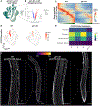Brassinosteroid gene regulatory networks at cellular resolution in the Arabidopsis root
- PMID: 36996230
- PMCID: PMC10119888
- DOI: 10.1126/science.adf4721
Brassinosteroid gene regulatory networks at cellular resolution in the Arabidopsis root
Abstract
Brassinosteroids are plant steroid hormones that regulate diverse processes, such as cell division and cell elongation, through gene regulatory networks that vary in space and time. By using time series single-cell RNA sequencing to profile brassinosteroid-responsive gene expression specific to different cell types and developmental stages of the Arabidopsis root, we identified the elongating cortex as a site where brassinosteroids trigger a shift from proliferation to elongation associated with increased expression of cell wall-related genes. Our analysis revealed HOMEOBOX FROM ARABIDOPSIS THALIANA 7 (HAT7) and GT-2-LIKE 1 (GTL1) as brassinosteroid-responsive transcription factors that regulate cortex cell elongation. These results establish the cortex as a site of brassinosteroid-mediated growth and unveil a brassinosteroid signaling network regulating the transition from proliferation to elongation, which illuminates aspects of spatiotemporal hormone responses.
Conflict of interest statement
Competing interests:
P.N.B. is the co-founder and Chair of the Scientific Advisory Board of Hi Fidelity Technologies, a company that works on crop root growth.
Figures







References
MeSH terms
Substances
Grants and funding
LinkOut - more resources
Full Text Sources
Other Literature Sources
Molecular Biology Databases
Research Materials
Miscellaneous

